Abstract
Since concomitant release of structurally related peptide hormones with apparently similar functions seems to be a general concept in endocrinology, we have studied the dynamics of the lifetime of the three known adipokinetic hormones (AKHs) of the migratory locust, which control flight-directed mobilization of carbohydrate and lipid from fat body stores. Although the structure of the first member of the AKHs has been known for 20 years, until now, reliable data on their inactivation and removal from the hemolymph are lacking, because measurement requires AKHs with high specific radioactivity. Employing tritiated AKHs with high specific radioactivity, obtained by catalytic reduction with tritium gas of the dehydroLeu2 analogues of the AKHs synthesized by the solid-phase procedure, studies with physiological doses of as low as 1.0 pmol per locust could be conducted. The AKHs appear to be transported in the hemolymph in their free forms and not associated with a carrier protein, despite their strong hydrophobicity. Application of AKHs in their free form in in vivo and in vitro studies therefore now has been justified. We have studied the degradation of the three AKHs during rest and flight. The first cleavage step by an endopeptidase is crucial, since the resulting degradation products lack any adipokinetic activity. Half-lives for AKH-I, -II and -III were 51, 40, and 5 min, respectively, for rest conditions and 35, 37, and 3 min, respectively, during flight. The rapid and differential degradation of structurally related hormones leads to changes in the ratio in which they are released and therefore will have important consequences for concerted hormone action at the level of the target organ or organs, suggesting that each of the known AKHs may play its own biological role in the overall syndrome of insect flight.
Full text
PDF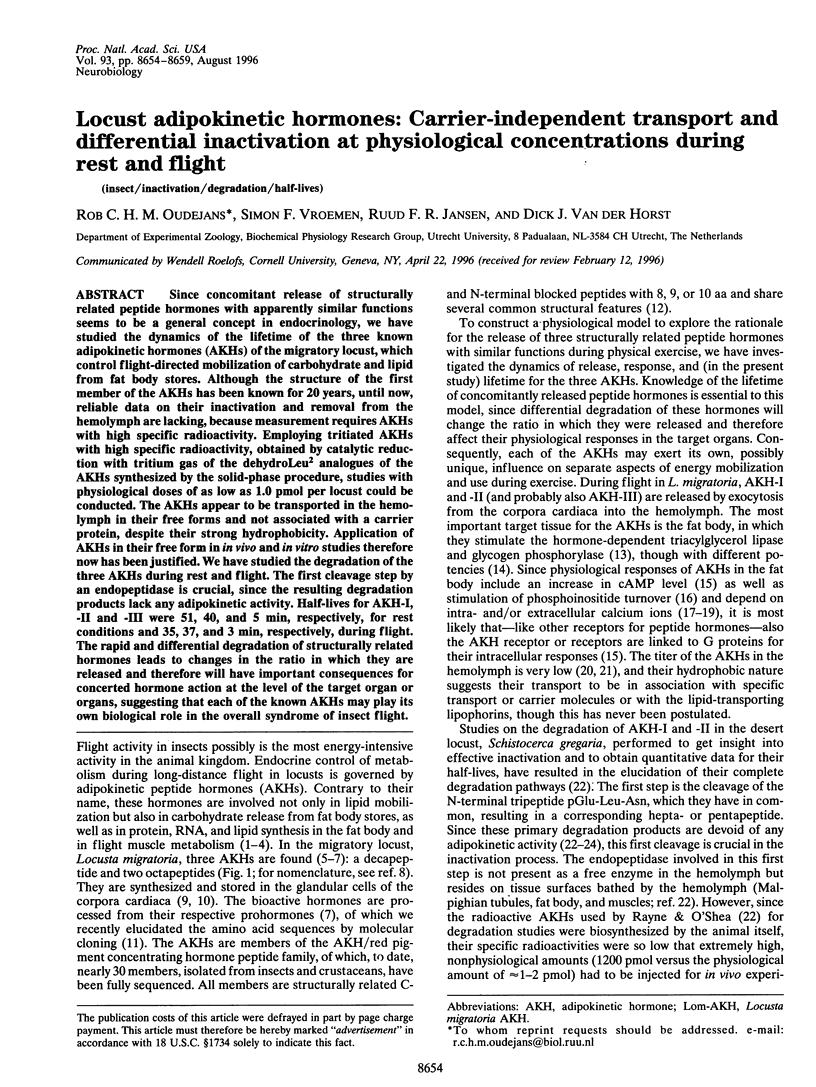

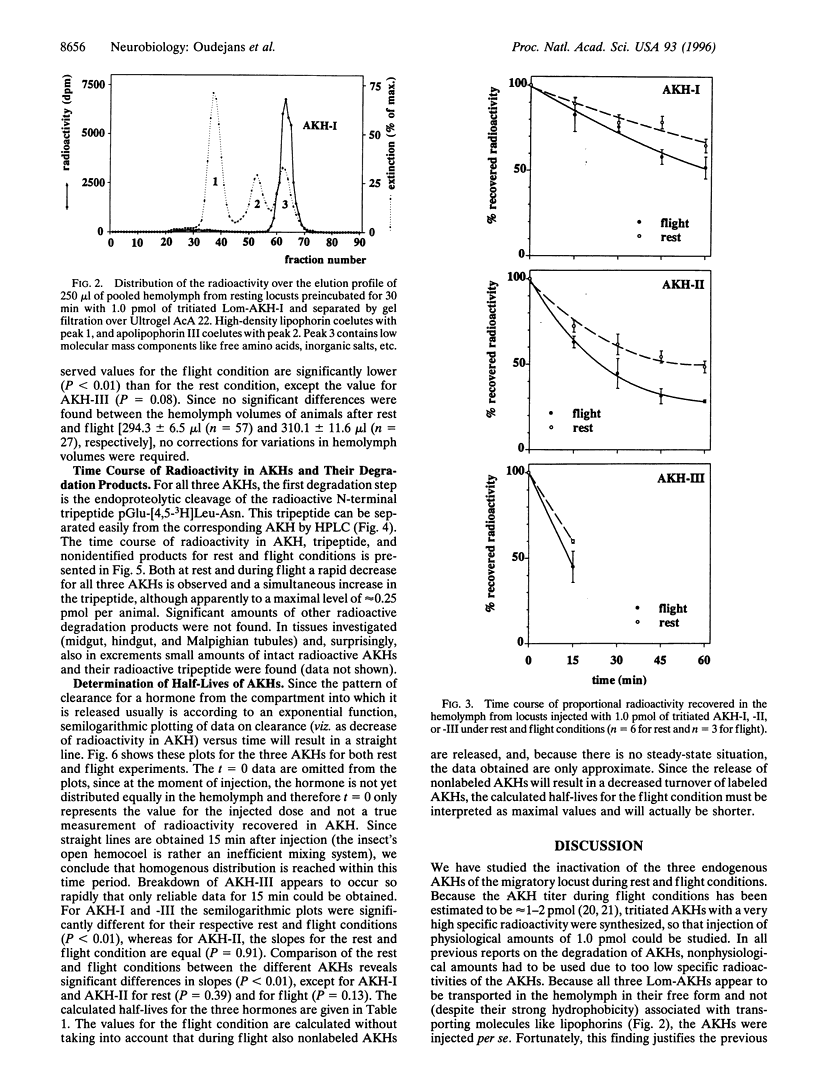
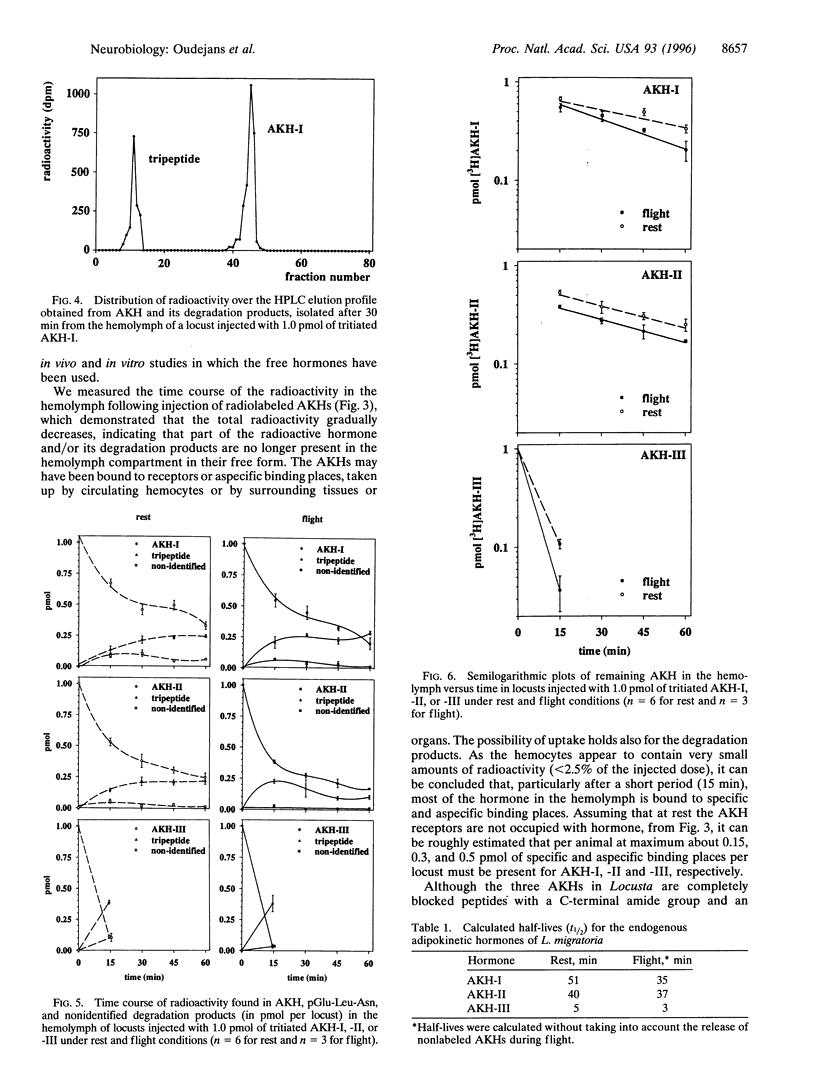
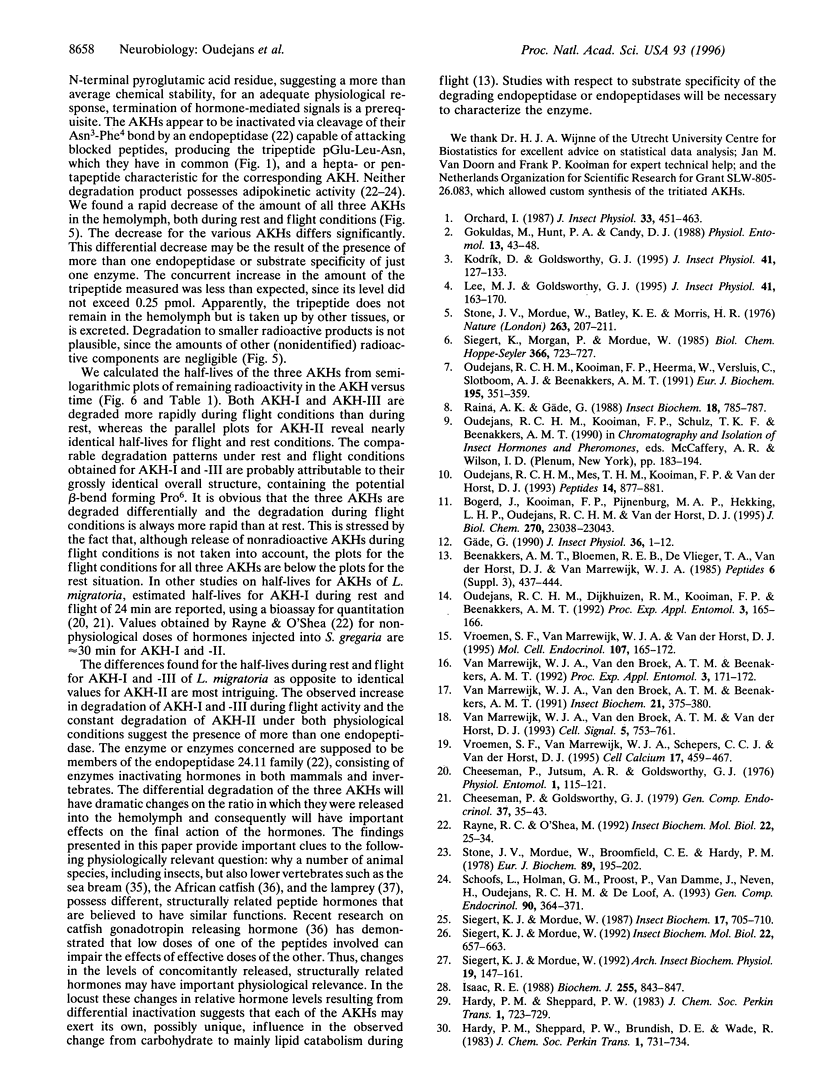
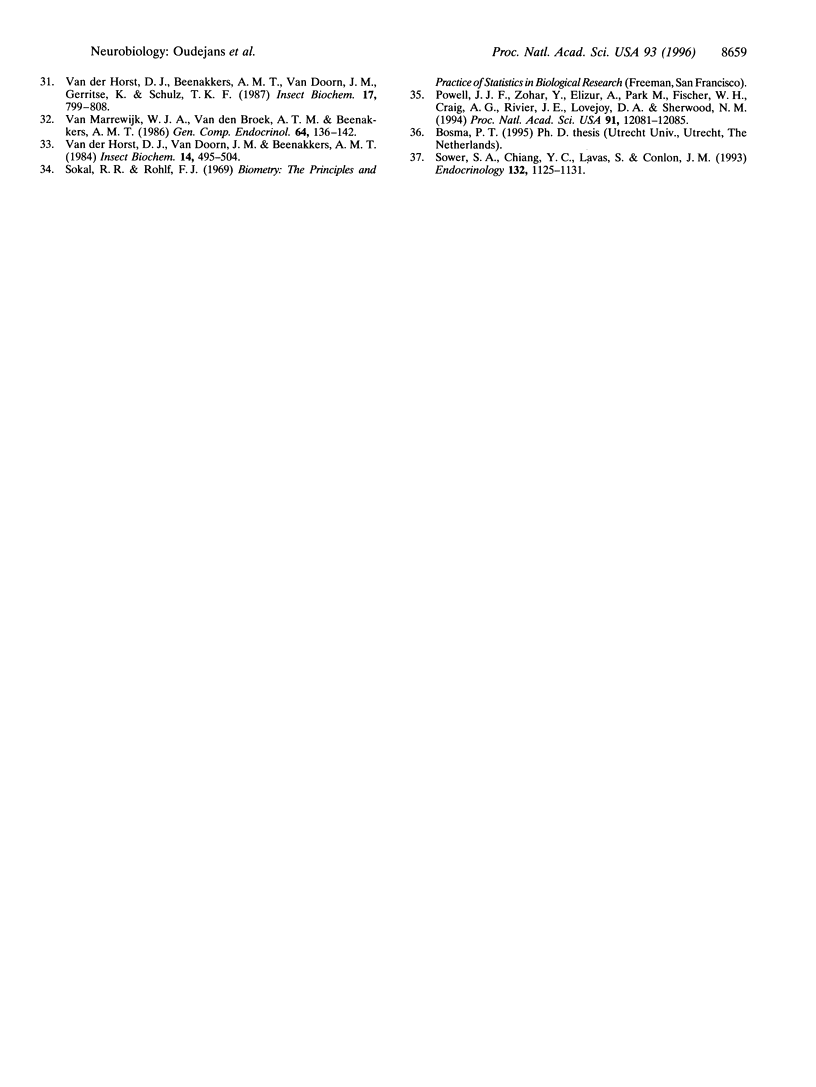
Selected References
These references are in PubMed. This may not be the complete list of references from this article.
- Beenakkers A. M., Bloemen R. E., De Vlieger T. A., Van der Horst D. J., Van Marrewijk W. J. Insect adipokinetic hormones. Peptides. 1985;6 (Suppl 3):437–444. doi: 10.1016/0196-9781(85)90411-5. [DOI] [PubMed] [Google Scholar]
- Bogerd J., Kooiman F. P., Pijnenburg M. A., Hekking L. H., Oudejans R. C., Van der Horst D. J. Molecular cloning of three distinct cDNAs, each encoding a different adipokinetic hormone precursor, of the migratory locust, Locusta migratoria. Differential expression of the distinct adipokinetic hormone precursor genes during flight activity. J Biol Chem. 1995 Sep 29;270(39):23038–23043. doi: 10.1074/jbc.270.39.23038. [DOI] [PubMed] [Google Scholar]
- Cheeseman P., Goldsworthy G. J. The release of adipokinetic hormone during flight and starvation in Locusta. Gen Comp Endocrinol. 1979 Jan;37(1):35–43. doi: 10.1016/0016-6480(79)90043-1. [DOI] [PubMed] [Google Scholar]
- Isaac R. E. Neuropeptide-degrading endopeptidase activity of locust (Schistocerca gregaria) synaptic membranes. Biochem J. 1988 Nov 1;255(3):843–847. doi: 10.1042/bj2550843. [DOI] [PMC free article] [PubMed] [Google Scholar]
- Oudejans R. C., Kooiman F. P., Heerma W., Versluis C., Slotboom A. J., Beenakkers M. T. Isolation and structure elucidation of a novel adipokinetic hormone (Lom-AKH-III) from the glandular lobes of the corpus cardiacum of the migratory locust, Locusta migratoria. Eur J Biochem. 1991 Jan 30;195(2):351–359. doi: 10.1111/j.1432-1033.1991.tb15713.x. [DOI] [PubMed] [Google Scholar]
- Oudejans R. C., Mes T. H., Kooiman F. P., van der Horst D. J. Adipokinetic peptide hormone content and biosynthesis during locust development. Peptides. 1993 Sep-Oct;14(5):877–881. doi: 10.1016/0196-9781(93)90062-l. [DOI] [PubMed] [Google Scholar]
- Powell J. F., Zohar Y., Elizur A., Park M., Fischer W. H., Craig A. G., Rivier J. E., Lovejoy D. A., Sherwood N. M. Three forms of gonadotropin-releasing hormone characterized from brains of one species. Proc Natl Acad Sci U S A. 1994 Dec 6;91(25):12081–12085. doi: 10.1073/pnas.91.25.12081. [DOI] [PMC free article] [PubMed] [Google Scholar]
- Schoofs L., Holman G. M., Proost P., Van Damme J., Neven H., Oudejans R. C., De Loof A. Isolation, identification, and synthesis of AKH-I4-10 from Locusta migratoria. Gen Comp Endocrinol. 1993 Jun;90(3):364–371. doi: 10.1006/gcen.1993.1092. [DOI] [PubMed] [Google Scholar]
- Siegert K., Morgan P., Mordue W. Primary structures of locust adipokinetic hormones II. Biol Chem Hoppe Seyler. 1985 Aug;366(8):723–727. doi: 10.1515/bchm3.1985.366.2.723. [DOI] [PubMed] [Google Scholar]
- Sower S. A., Chiang Y. C., Lovas S., Conlon J. M. Primary structure and biological activity of a third gonadotropin-releasing hormone from lamprey brain. Endocrinology. 1993 Mar;132(3):1125–1131. doi: 10.1210/endo.132.3.8440174. [DOI] [PubMed] [Google Scholar]
- Stone J. V., Mordue W., Batley K. E., Morris H. R. Structure of locust adipokinetic hormone, a neurohormone that regulates lipid utilisation during flight. Nature. 1976 Sep 16;263(5574):207–211. doi: 10.1038/263207a0. [DOI] [PubMed] [Google Scholar]
- Stone J. V., Mordue W., Broomfield C. E., Hardy P. M. Structure-activity relationships for the lipid-mobilising action of locust adipokinetic hormone. Synthesis and activity of a series of hormone analogues. Eur J Biochem. 1978 Aug 15;89(1):195–202. doi: 10.1111/j.1432-1033.1978.tb20912.x. [DOI] [PubMed] [Google Scholar]
- Van Marrewijk W. J., Van den Broek A. T., Van der Horst D. J. Adipokinetic hormone-induced influx of extracellular calcium into insect fat body cells is mediated through depletion of intracellular calcium stores. Cell Signal. 1993 Nov;5(6):753–761. doi: 10.1016/0898-6568(93)90036-l. [DOI] [PubMed] [Google Scholar]
- Vroemen S. F., Van Marrewijk W. J., Schepers C. C., Van der Horst D. J. Signal transduction of adipokinetic hormones involves Ca2+ fluxes and depends on extracellular Ca2+ to potentiate cAMP-induced activation of glycogen phosphorylase. Cell Calcium. 1995 Jun;17(6):459–467. doi: 10.1016/0143-4160(95)90092-6. [DOI] [PubMed] [Google Scholar]
- Vroemen S. F., Van Marrewijk W. J., Van der Horst D. J. Stimulation of glycogenolysis by three locust adipokinetic hormones involves Gs and cAMP. Mol Cell Endocrinol. 1995 Feb;107(2):165–171. doi: 10.1016/0303-7207(94)03438-y. [DOI] [PubMed] [Google Scholar]
- van Marrewijk W. J., van den Broek A. T., Beenakkers A. M. Hormonal control of fat-body glycogen mobilization for locust flight. Gen Comp Endocrinol. 1986 Oct;64(1):136–142. doi: 10.1016/0016-6480(86)90039-0. [DOI] [PubMed] [Google Scholar]


